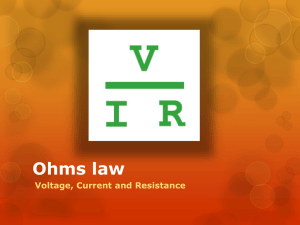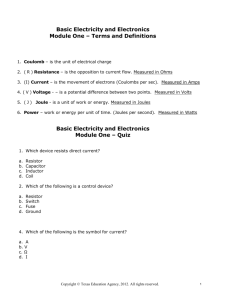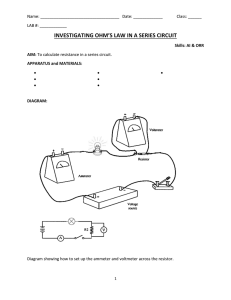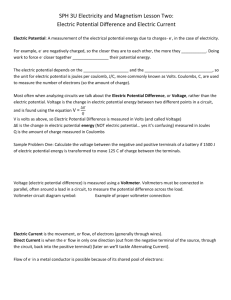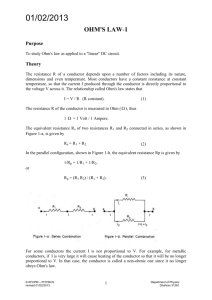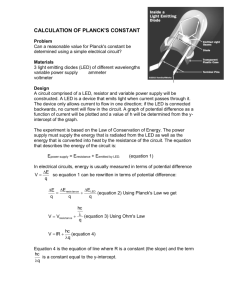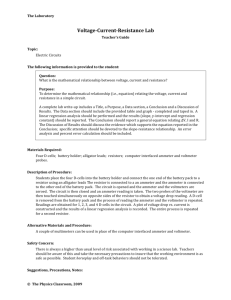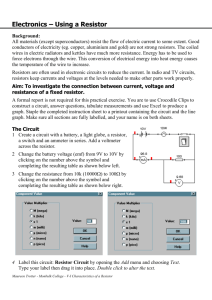Document
advertisement
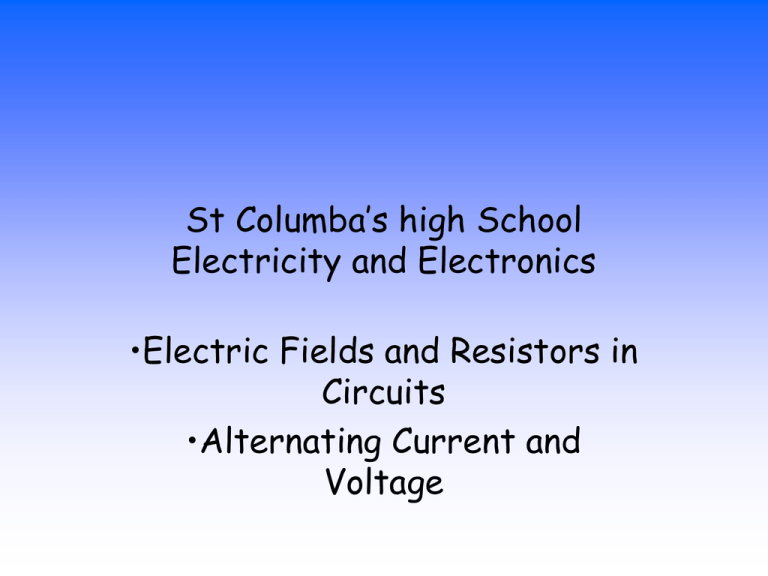
St Columba’s high School Electricity and Electronics •Electric Fields and Resistors in Circuits •Alternating Current and Voltage Which of the following statements is/are correct? A. There is a force on a charge in an E-field. B. When an E-field is applied to a conductor, free charges move through it. C. Work is done when a charge is moved in an E-field. ly A ,B an d on an d C C d 0% C 0% on ly on B on 0% ly 0% ly 0% an A only B only A and C only B and C only A, B and C A 1. 2. 3. 4. 5. 30 One Volt is……. O ne C ne Jo ul e C ou ou lo lo m O m b ne b pe Jo rS ul e ... pe O rC ne ou Jo lo ul m e O b pe ne r C Se ou co lo nd m b pe rJ ou le 0% 0% 0% 0% 0% O 1. One Joule Coulomb 2. One Coulomb per Second 3. One Joule per Coulomb 4. One Joule per Second 5. One Coulomb per Joule 30 Metal parallel plates X and Y are connected to a 3.0 V d.c. supply as shown. What is the gain in electrical potential energy of an electron moving between the plates? 0% 0% 0% 0% 0% 1. 2. 3. 4. 5. 1.6 x 10 –19 J 4.8 x 10 –19 J 9.6 x 10 –19 J 1.9 x 10 19 J 5.3 x 10 –20 J 3.0V Plate X Plate Y 90 Two parallel metal plates X and Y in a vacuum have a potential difference V across them. What is the speed of an electron of charge e and mass m as it reaches Y from X? 0% 0% 0% 0% 0% 1. 2eV/m 2. √2eV/m 3. √2V/em 4. 2V/em 5. 2mV/e X Y - + V 90 In the circuit below, when the switch is open V = 2.6V. With the switch closed, V= 2.2V. This decrease of 0.4 V is called… 0% 0% 0% 0% 0% 1. 2. 3. 4. 5. V Peak voltage e.m.f. r.m.s voltage Lost volts Terminal potential difference 0% 30 0% 0% 0% 0% 0% The battery in the circuit below has an emf of 6.0V and an internal resistance of 0.20 ohms. What is the resistance of R if the reading on the ammeter is 4A? 6.0V 1. 1.5 ohms 0.20 2. 2.2 ohms A 3. 1.3 ohms R 4. 0.7 0hms 5. 6.4 ohms 90 What is the p.d. across the 10 resistor? 0% 0% 0% 0% 0% 1. 2. 3. 4. 5. 1.0V 1.2V 4.8V 5.0V 6.0V 6.0V 2 A 10 90 The p.d. across the 16 ohm resistor is 40V when the switch is open. What is the p.d. across the 16 ohm resistor when S is closed? 0% 0% 0% 0% 0% 1. 2. 3. 4. 5. 12V 15V 30V 45V 48V 60V 8 S 16 8 90 0% 0% 0% 0% 0% In the circuit below, each resistor has a resistance of 20 ohms. What is the voltage across XY? 1. 3.5V 3.5V 2. 0.2V 3. 2.0V 4. 0.5V X Y 5. 1V 90 In the circuit shown, the p.d. between points P and Q is 12 V. What is the reading on the voltmeter? 0% 0% 0% 0% 0% 1. 2. 3. 4. 5. 0V 2V 4V 6V 8V P 2 4 Q V 4 8 30 In the Wheatstone bridge shown, there is a small reading on the voltmeter. What should be done to balance the bridge? 6 0% 0% 0% 0% 0% 1. 2. 3. 4. 5. 12 Increase P by 6 Q P Increase Q by 6 R S 4 12 Increase R by 6 Increase S by 6 Insert a 6 resistor in series with the voltmeter. V 90 What is the total power developed in the circuit below? 0% 0% 0% 0% 0% 1. 2. 3. 4. 5. 12W 24W 48W 300W 1200W 12V 6 6 90 In the circuit below, the frequency of the a.c. supply output is varied in frequency from 50Hz to 5kHz. What is the ammeter reading? 0% 0% 0% 0% 0% 1. 2. 3. 4. 5. Falls steadily Remains constant Rises then falls Rises steadily Falls then rises A 1K 30 A supply with alternating output 6V r.m.s. is connected as shown. What is the peak voltage across the resistor and the peak current in the circuit? 0% 0% 0% 0% 0% 1. 2. 3. 4. 5. Vp=6√2 Vp=6√2 Vp=6 Vp=6√2 Vp=6 Ip=2√2 Ip=2 Ip=2 Ip=1/(2√2) Ip=2√2 6V 3 90 The resistance of the LDR decreases when the light intensity increases. Which row shows the correct voltmeter readings when the lights are off? 1. 2. 3. 4. 5. V1= increases V2 = increases V1= decreases V3 = increases V2 = increases V3 = decreases V2 = no change V3 = decreases V1= decreases V2 = no change - V1 V + V2 V3 The peak voltage of a supply is 70V. What is the r.m.s. value? 99.0V 35.0V 17.5V 49.5V 50.3V .3 50 .5 49 V 0% V 0% V .5 17 .0 35 .0 0% V 0% V 0% 99 1. 2. 3. 4. 5. 90 A student measures the frequency of an a.c. supply and obtains the trace below. If the grid has 1cm squares, what is the frequency of the supply? 0% 0% 0% 0% 0% 1. 2. 3. 4. 5. 0.06Hz 0.17Hz 41.7Hz 62.5Hz 125Hz Y-gain = 3mV/cm Timebase = 2ms/cm 90
